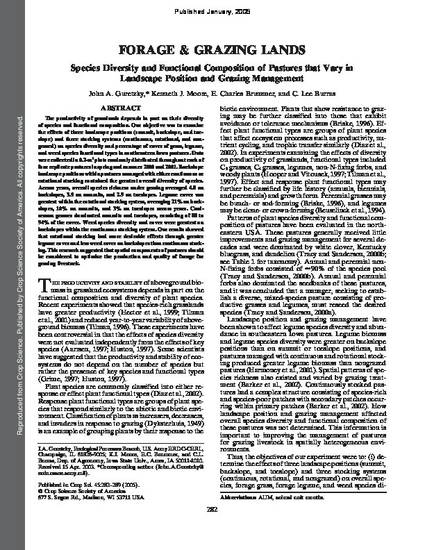
The productivity of grasslands depends in part on their diversity of species and functional composition. Our objective was to examine the effects of three landscape positions (summit, backslope, and toeslope) and three stocking systems (continuous, rotational, and nongrazed) on species diversity and percentage of cover of grass, legume, and weed species functional types in southeastern Iowa pastures. Data were collected in 0.2-m2 plots randomly distributed throughout each of four replicate pastures in spring and summer 2000 and 2001. Backslope landscape positions within pastures managed with either continuous or rotational stocking contained the greatest overall diversity of species. Across years, overall species richness under grazing averaged 4.8 on backslopes, 3.5 on summits, and 2.9 on toeslopes. Legume cover was greatest within the rotational stocking system, averaging 21% on backslopes, 10% on summits, and 3% on toeslopes across years. Cool-season grasses dominated summits and toeslopes, consisting of 88 to 94% of the cover. Weed species diversity and cover were greatest on backslopes within the continuous stocking system. Our results showed that rotational stocking had more desirable effects through greater legume cover and less weed cover on backslopes than continuous stocking. This research suggested that spatial components of pastures should be considered to optimize the production and quality of forage for grazing livestock.
Available at: http://works.bepress.com/c_burras/33/

This article is published as Guretzky, John A., Kenneth J. Moore, E. Charles Brummer, and C. Lee Burras. "Species diversity and functional composition of pastures that vary in landscape position and grazing management." Crop science 45, no. 1 (2005): 282-289. doi: 10.2135/cropsci2005.0282.